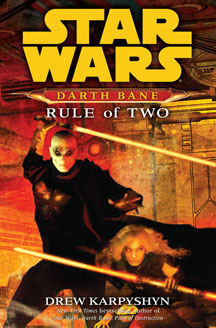Drew Karpyshyn’s “Darth Bane: Path of Destruction” put a tidy symbolic bow on two pieces of Sith lore that are known to the Jedi in “Episode I”: 1) That the Sith have been extinct for a millennium, and 2) That there are always two Sith lords – a master and an apprentice. In the closing pages, Darth Bane takes Zannah as his apprentice and presumably that sets up 1,000 years of Sith lords handing off the baton until we meet Darths Sidious and Maul.
Karpyshyn’s sequel, “Darth Bane: Rule of Two” (2008), seems to exist due to the commercial success of the first novel more so than creative reasons. However, the more I think about it, the more I realize “Path of Destruction” left a major point unresolved: While it chronicles the major event that marks the end of the Sith (the Brotherhood of Darkness’ defeat at the Seventh Battle of Ruusan), it does not explain how the Jedi know about the Rule of Two. After all, Bane devises the Rule of Two in the aftermath of the Sith’s “extinction.”
So Karpyshyn finds himself with the awkward task of setting up the history so it’s commonly accepted that the Sith died out during this time, yet the Jedi believe the Rule of Two (rather than the Brotherhood of Darkness’ philosophy of “equality” among hundreds of Sith lords) was the prominent philosophy when the galaxy was last menaced by the Sith.
“Rule of Two” doesn’t explain how the titular philosophy becomes common Jedi knowledge, but it does tease the reader several times. In the wake of the Seventh Battle of Ruusan, 19-year-old Jedi Johun Othone finds evidence of a surviving Sith lord on Ruusan. The opinion leaders among the Jedi – including Johun’s master, Valenthyne Farfalla — don’t believe him, nor do the opinion leaders among the Republic – including Supreme Chancellor Tarsus Valorum. In the final act, Zannah and Bane trick a group of Jedi into thinking they’ve wiped out Bane, and therefore the Sith. There’s no evidence that these Jedi acquire any knowledge of the Rule of Two; as far as they know, they simply dispatched the final Sith straggler. Perhaps the Jedi will gain the knowledge in the “Bane” trilogy’s final book, “Dynasty of Evil.”
A sequel to both “Path of Destruction” and the comic series “Jedi vs. Sith,” “Rule of Two” is a treasure trove of connections to even more Expanded Universe lore. It chronicles the Republic’s construction of the Valley of the Jedi, a monument to the 100 fallen Jedi in the Seventh Battle of Ruusan, first seen in the illustrated novel “Dark Forces: Jedi Knight.” And it chronicles the Ruusan Reformation – Valorum’s symbolic but effective legislation that reorganizes the Republic. This is an essential retcon in EU lore as it explains why the Republic is referred to as being 1,000 years old in the prequels despite the fact that it goes back many more millennia in the comics and novels (“Tales of the Jedi,” for example, is set 4,000 years before the films). Additionally, the Ruusan Reformation establishes the Republic as keeping the Jedi on a shorter leash – a political quagmire that will factor into the prequels.

Karpyshyn borrows elements from “Bane of the Sith,” Kevin J. Anderson’s short story in Star Wars Gamer Issue 3. As in the first book, Bane is not plotting to take over the galaxy or even to carve out a little kingdom such as Joruus C’baoth will have in “Heir to the Empire.” Rather, he’s on a knowledge quest. It’s a compelling one if you’re a fan of Sith lore or galactic geography. Bane goes to Dxun (from the “Tales of the Jedi” comics) to search the tomb of Freedon Nadd, then travels to Tython in search of knowledge about Sith alchemy. Bane knows Tython is rumored to be the birthplace of the Jedi and Sith; this would later be confirmed in the “Dawn of the Jedi” novel and comics, set 25,000 years before the movies.
“Rule of Two” isn’t as strong as “Path of Destruction” largely because Karpyshyn falls back on common “Star Wars” tropes as a foundation for Bane’s and Zannah’s character arcs. For example, we learn of a separatist group on Serenno, but the Republic vs. separatist political conflict isn’t articulated. And there are a ton of lightsaber duels – although I admit Karpyshyn makes them more readable than the norm with his descriptions of the seven forms of combat.
While it’s incredibly convenient, I admit it’s fun to see the reunion of Zannah (known as Rain in “Jedi vs. Sith”) and her cousin, Darovit (a.k.a. Tomcat). At this point in the trilogy, it’s still entertaining to get into Zannah’s head as she lusts after Sith knowledge, although if memory serves, it gets old in “Dynasty of Evil” as the Rule of Two begins to seem more symbolic than substantial.
Even in “Rule of Two,” a dark-sider named Hetton and eight of his disciples attack Bane. Along with Zannah, that’s 11 dark-side users in this book. Bane and his adherents can claim there are only two Sith at a time, but throughout “Star Wars” lore, it’s clear there’s never a point where there are only two dark Force users. “Sith,” “Dark Lord” and “Darth” are all self-anointed titles.
And while Palpatine benefits from the Rule of Two, he doesn’t believe in it: In “Rebels,” he has at least two dark-siders – Darth Vader and the Inquisitor – at his disposal, and last we heard in “The Clone Wars,” he had plans for Darth Maul, as well. Perhaps Barriss Offee is also on his radar. And that’s just citing Disney canon sources; the EU provides too many dark-siders working under Palpatine to bother listing them all.
As a “Star Wars” history lesson, “Rule of Two” is entertaining. However, I found myself more removed from Bane, Zannah and Darovit than in previous works. “Rule of Two” is an important sequel to “Path of Destruction” and “Jedi vs. Sith,” but it doesn’t provide the same emotional impact as those outstanding character pieces.

